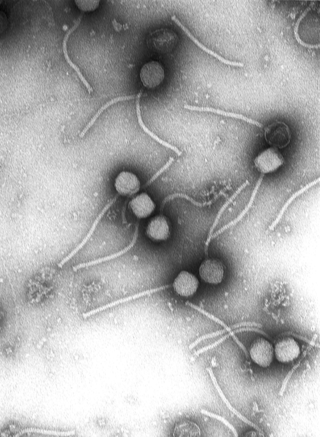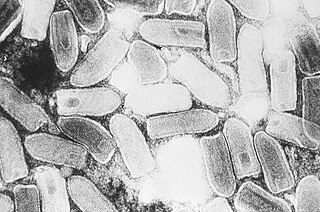
Virology is the scientific study of biological viruses. It is a subfield of microbiology that focuses on their detection, structure, classification and evolution, their methods of infection and exploitation of host cells for reproduction, their interaction with host organism physiology and immunity, the diseases they cause, the techniques to isolate and culture them, and their use in research and therapy.

Indiana vesiculovirus, formerly Vesicular stomatitis Indiana virus is a virus in the family Rhabdoviridae; the well-known Rabies lyssavirus belongs to the same family. VSIV can infect insects, cattle, horses and pigs. It has particular importance to farmers in certain regions of the world where it infects cattle. This is because its clinical presentation is identical to the very important foot and mouth disease virus.
A superinfection is a second infection superimposed on an earlier one, especially by a different microbial agent of exogenous or endogenous origin, that is resistant to the treatment being used against the first infection. Examples of this in bacteriology are the overgrowth of endogenous Clostridium difficile that occurs following treatment with a broad-spectrum antibiotic, and pneumonia or sepsis from Pseudomonas aeruginosa in some immunocompromised patients.

Severe acute respiratory syndrome coronavirus 1 (SARS-CoV-1), previously known as severe acute respiratory syndrome coronavirus (SARS-CoV), is a strain of coronavirus that causes severe acute respiratory syndrome (SARS), the respiratory illness responsible for the 2002–2004 SARS outbreak. It is an enveloped, positive-sense, single-stranded RNA virus that infects the epithelial cells within the lungs. The virus enters the host cell by binding to angiotensin-converting enzyme 2. It infects humans, bats, and palm civets. The SARS-CoV-1 outbreak was largely brought under control by simple public health measures. Testing people with symptoms, isolating and quarantining suspected cases, and restricting travel all had an effect. SARS-CoV-1 was most transmissible when patients were sick, so its spread could be effectively suppressed by isolating patients with symptoms.

Human herpesvirus 6 (HHV-6) is the common collective name for human betaherpesvirus 6A (HHV-6A) and human betaherpesvirus 6B (HHV-6B). These closely related viruses are two of the nine known herpesviruses that have humans as their primary host.
Viral culture is a laboratory technique in which samples of a virus are placed to different cell lines which the virus being tested for its ability to infect. If the cells show changes, known as cytopathic effects, then the culture is positive.
In the diagnostic laboratory, virus infections can be confirmed by a myriad of methods. Diagnostic virology has changed rapidly due to the advent of molecular techniques and increased clinical sensitivity of serological assays.
Multiplex polymerase chain reaction refers to the use of polymerase chain reaction to amplify several different DNA sequences simultaneously. This process amplifies DNA in samples using multiple primers and a temperature-mediated DNA polymerase in a thermal cycler. The primer design for all primers pairs has to be optimized so that all primer pairs can work at the same annealing temperature during PCR.

ORF7a is a gene found in coronaviruses of the Betacoronavirus genus. It expresses the Betacoronavirus NS7A protein, a type I transmembrane protein with an immunoglobulin-like protein domain. It was first discovered in SARS-CoV, the virus that causes severe acute respiratory syndrome (SARS). The homolog in SARS-CoV-2, the virus that causes COVID-19, has about 85% sequence identity to the SARS-CoV protein.
Shi Zhengli is a Chinese virologist who researches SARS-like coronaviruses of bat origin. Shi directs the Center for Emerging Infectious Diseases at the Wuhan Institute of Virology (WIV). In 2017, Shi and her colleague Cui Jie discovered that the SARS coronavirus likely originated in a population of cave-dwelling horseshoe bats in Xiyang Yi Ethnic Township, Yunnan. She came to prominence in the popular press as "Batwoman" during the COVID-19 pandemic for her work with bat coronaviruses. Shi was included in Time's 100 Most Influential People of 2020.

The Wuhan Institute of Virology, Chinese Academy of Sciences is a research institute on virology administered by the Chinese Academy of Sciences (CAS), which reports to the State Council of the People's Republic of China. The institute is one of nine independent organisations in the Wuhan Branch of the CAS. Located in Jiangxia District, Wuhan, Hubei, it was founded in 1956 and opened mainland China's first biosafety level 4 (BSL-4) laboratory in 2018. The institute has collaborated with the Galveston National Laboratory in the United States, the Centre International de Recherche en Infectiologie in France, and the National Microbiology Laboratory in Canada. The institute has been an active premier research center for the study of coronaviruses.

Since the beginning of the COVID-19 pandemic, there have been efforts by scientists, governments, and others to determine the origin of the SARS-CoV-2 virus. Similar to other outbreaks, the virus derived from a bat-borne virus and most likely was transmitted to humans via another animal in nature or during wildlife trade such as that in food markets. While other explanations such as speculations that SARS-CoV-2 was accidentally released from a laboratory have been proposed, such explanations are not supported by evidence. Conspiracy theories about the virus's origin have also proliferated.

The COVID-19 lab leak theory, or lab leak hypothesis, is the idea that SARS-CoV-2, the virus that caused the COVID-19 pandemic, came from a laboratory. This claim is highly controversial; most scientists believe the virus spilled into human populations through natural zoonosis, similar to the SARS-CoV-1 and MERS-CoV outbreaks, and consistent with other pandemics in human history. Available evidence suggests that the SARS-CoV-2 virus was originally harbored by bats, and spread to humans from infected wild animals, functioning as an intermediate host, at the Huanan Seafood Market in Wuhan, Hubei, China, in December 2019. Several candidate animal species have been identified as potential intermediate hosts. There is no evidence SARS-CoV-2 existed in any laboratory prior to the pandemic, or that any suspicious biosecurity incidents happened in any laboratory.

A viral vector vaccine is a vaccine that uses a viral vector to deliver genetic material (DNA) that can be transcribed by the recipient's host cells as mRNA coding for a desired protein, or antigen, to elicit an immune response. As of April 2021, six viral vector vaccines, four COVID-19 vaccines and two Ebola vaccines, have been authorized for use in humans.
DRASTIC is a loose collection of internet activists assembled to investigate the origins of COVID-19, in particular the lab leak theory. Composed of about 30 core members, and primarily organized through the social media website Twitter, DRASTIC was formed in February 2020, at the start of the COVID-19 pandemic. DRASTIC members called for a "full and unrestricted investigation" into the origins of COVID-19, conducted independently of the World Health Organization; most scientists thought that COVID-19 likely had a natural origin, and some considered that a potential lab leak was worth investigating.
Trevor Bedford is an American computational virologist at Fred Hutchinson Cancer Research Center.
Jesse D. Bloom is an American computational virologist and Professor in the Basic Sciences Division, the Public Health Sciences Division, and the Herbold Computational Biology Program, at the Fred Hutchinson Cancer Center. He is also an Investigator of the Howard Hughes Medical Institute, and an Affiliate Professor in the University of Washington departments of Genome Sciences and Microbiology.
William Paul Duprex is a British scientist and advocate for vaccines and global health. He serves as Director of the University of Pittsburgh's Center for Vaccine Research and Regional Biocontainment Laboratory. Duprex holds the Jonas Salk Chair in Vaccine Research. He is also a professor of microbiology and molecular genetics at the University of Pittsburgh School of Medicine and serves as Editor-in-Chief of the Journal of General Virology, which is published by the Microbiology Society, and a senior editor of mSphere, published by the American Society for Microbiology. Duprex is an expert in measles and mumps viruses and studies viral spillover from animals to humans, including the SARS-CoV-2 virus that caused the COVID-19 pandemic. Duprex is a Fellow of the American Academy of Microbiology.
Alexander L. Greninger is assistant director of the UW Medicine Clinical Virology Laboratory and a UW assistant professor of Laboratory Medicine. His research is focused on genomic and proteomic characterization of a variety of human viruses and bacteria, with a focus on respiratory viruses and human herpesviruses.
Anne Moscona is an American virologist and pediatrician. She is best known for identifying cell entry mechanisms for enveloped respiratory viruses, elucidating general infection mechanisms that apply to parainfluenza virus, Nipah virus, measles virus, and other viruses, and for applying this knowledge to identify antiviral strategies to prevent infection by viruses including SARS-CoV-2. She is frequently consulted as a medical expert during viral outbreaks, including epidemic and pandemic influenza. Since 2016, she has served as the Sherie L. Morrison Professor Microbiology & Immunology, Professor of Pediatrics, and Professor of Physiology & Cellular Biophysics at Columbia University Medical Center in New York City, where she directs the Center for Host Pathogen Interaction. In 2022, Moscona was elected as president of the American Society for Virology, the nation's leading virology research organization, and will lead the organization starting in July 2023. For the last two years she has served the American Society for Virology as Councilor for Medical Virology.







